Management of Hypertensive Diabetic Patients: A Case Study of Bill McDonald
VerifiedAdded on 2023/06/05
|11
|3034
|142
AI Summary
This essay examines a patient with diabetes who has hypertension as the main health issue too. The essay discusses about the potential management approach need for caring for a hypertensive diabetic patient. The essay also presented potential management approach for management of hypertensive diabetes patients. Pharmacological interventions like ACE inhibitors combined with other drugs and lifestyle interventions have been identified as potential approach to promote health of hypertensive patients with diabetes.
Contribute Materials
Your contribution can guide someone’s learning journey. Share your
documents today.
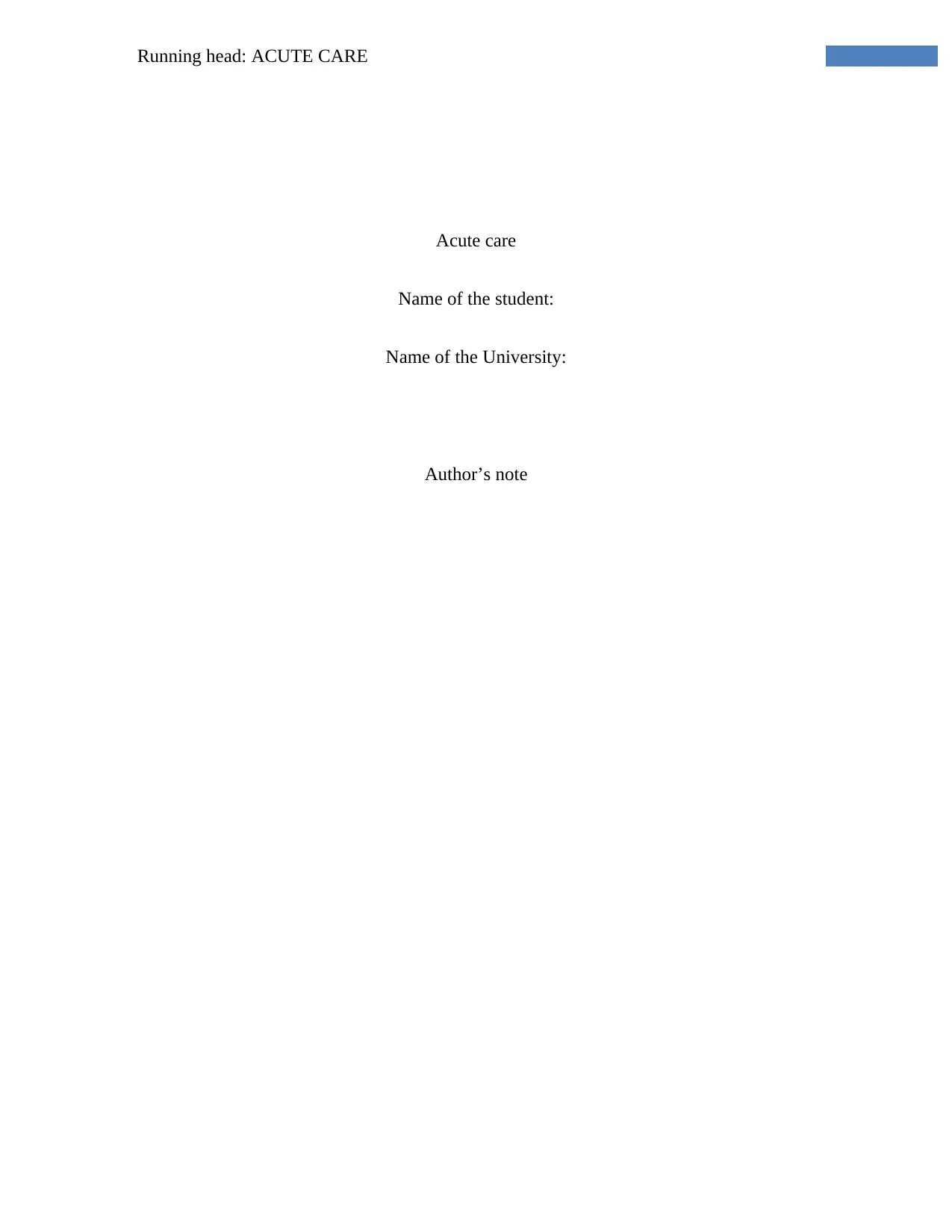
Running head: ACUTE CARE
Acute care
Name of the student:
Name of the University:
Author’s note
Acute care
Name of the student:
Name of the University:
Author’s note
Secure Best Marks with AI Grader
Need help grading? Try our AI Grader for instant feedback on your assignments.

1ACUTE CARE
Diabetes and hypertension are two heath conditions that are often found together in many
person and sharing common etiology and disease mechanism is the main reason that explains
why the two conditions co-exists in many person. This essay focussed on examining a patient
with diabetes who has hypertension as the main health issue too. The patient under study is Bill
McDonald, a 58 year old male patient who has a history of type 2 diabetes and he came to the
GP to the emergency department with symptoms of fatigue, painful feet and nausea. The main
purpose of this essay is to further examine Mr. Bill’s chronic symptoms and discuss the
pathophysiology associated with the condition. The essay discusses about the potential
management approach need for caring for a hypertensive diabetic patient. A comprehensive
education plan will also be developed to ensure that his treatment needs associated with
progression of the disease is met.
Bill is a patient with type 2 diabetes and on visit to the GP one week ago, he was found to
have a blood pressure of 170/100 mmHg. However, he had not other symptom of type 2 diabetes
at that time apart from the complaint that his eyes get tired easily. After the 4 day business trip to
Sydney, he is experiencing symptom of fatigue, nausea and pain in the feet. The current
symptom after the business trip suggests that his condition is deteriorating and many
pathophysiological changes is the reason behind his current symptoms. The common
pathophysiological mechanism associated with type 2 diabetes includes impaired insulin
secretion and insulin resistance. It is a condition that leads to inadequate insulin secretion from
the pancreatic beta cell and increase in glucagon secretion (Zaccardi et al., 2016). Insulin
resistance is mainly caused by obesity and physical inactivity. Insulin resistance is a condition
that leads to decrease in glucose responsiveness. The deposition of fat in the liver and muscles
results in the development of insulin resistance. As the fats deposits in the pancreas, it lead to
Diabetes and hypertension are two heath conditions that are often found together in many
person and sharing common etiology and disease mechanism is the main reason that explains
why the two conditions co-exists in many person. This essay focussed on examining a patient
with diabetes who has hypertension as the main health issue too. The patient under study is Bill
McDonald, a 58 year old male patient who has a history of type 2 diabetes and he came to the
GP to the emergency department with symptoms of fatigue, painful feet and nausea. The main
purpose of this essay is to further examine Mr. Bill’s chronic symptoms and discuss the
pathophysiology associated with the condition. The essay discusses about the potential
management approach need for caring for a hypertensive diabetic patient. A comprehensive
education plan will also be developed to ensure that his treatment needs associated with
progression of the disease is met.
Bill is a patient with type 2 diabetes and on visit to the GP one week ago, he was found to
have a blood pressure of 170/100 mmHg. However, he had not other symptom of type 2 diabetes
at that time apart from the complaint that his eyes get tired easily. After the 4 day business trip to
Sydney, he is experiencing symptom of fatigue, nausea and pain in the feet. The current
symptom after the business trip suggests that his condition is deteriorating and many
pathophysiological changes is the reason behind his current symptoms. The common
pathophysiological mechanism associated with type 2 diabetes includes impaired insulin
secretion and insulin resistance. It is a condition that leads to inadequate insulin secretion from
the pancreatic beta cell and increase in glucagon secretion (Zaccardi et al., 2016). Insulin
resistance is mainly caused by obesity and physical inactivity. Insulin resistance is a condition
that leads to decrease in glucose responsiveness. The deposition of fat in the liver and muscles
results in the development of insulin resistance. As the fats deposits in the pancreas, it lead to

2ACUTE CARE
impaired beta cell function, islet inflammation and eventually beta cell death. It results in
hypergylcemia and increase in risk of many microvascular and microvascular complication
(Kahn, Cooper & Del Prato, 2013).
One of the chronic symptoms that have been observed in Mr. Bill includes fatigue.
Fatigue in diabetes may be linked to the physiological phenomena of hyperglycemia and it may
also be linked to lifestyle issues such as being overweight and lack of physical activity. Mr.
Bill’s weight is 120 kg and he has a sedentary lifestyle. These lifestyle factors might also leading
to fatigue for the patient (Fritschi & Quinn, 2010). Chronic hyperglycemia is often linked to
fatigue. Patients with well controlled HbA1c level are less likely to suffer from fatigue. Fatigue
is the common presenting symptom of many diabetes patient (Park et al., 2015). The
pathophysiological changes associated with fatigue in diabetic patients include biochemical and
ionic changes in muscles and its impact on contractile properties of organ. High level of
hydrogen ions and presence of phosphate and potassium is also a mechanism associated with
fatigue. In people with diabetes, shift in energy substrate occurs because of lack of insulin as per
body’s need. Due to this process, the ADP phophorylation rate falls and the ATP resynthesis rate
decreases. This process leads to the occurrence of fatigue in diabetes patients (Kalra & Sahay,
2018). Similar process might be the reason for Mr. Bill to experience such symptoms.
Another chronic symptom that has been observed in Mr. Bill includes pain in the feet. On
going to a 4-day business trip, Mr. Bill complained about painful feet during the trip. On
physical examination of the patient, open ulcer has been found too. Foot pain is a nerve problem
that occurs due to the physiological mechanism of peripheral neuropathy. Peripheral neuropathy
is a type of nerve damage that occurs in diabetes patients because of high blood sugar level for a
long time. This can damage nerves throughout the body and result in pain in the feet and ulcers
impaired beta cell function, islet inflammation and eventually beta cell death. It results in
hypergylcemia and increase in risk of many microvascular and microvascular complication
(Kahn, Cooper & Del Prato, 2013).
One of the chronic symptoms that have been observed in Mr. Bill includes fatigue.
Fatigue in diabetes may be linked to the physiological phenomena of hyperglycemia and it may
also be linked to lifestyle issues such as being overweight and lack of physical activity. Mr.
Bill’s weight is 120 kg and he has a sedentary lifestyle. These lifestyle factors might also leading
to fatigue for the patient (Fritschi & Quinn, 2010). Chronic hyperglycemia is often linked to
fatigue. Patients with well controlled HbA1c level are less likely to suffer from fatigue. Fatigue
is the common presenting symptom of many diabetes patient (Park et al., 2015). The
pathophysiological changes associated with fatigue in diabetic patients include biochemical and
ionic changes in muscles and its impact on contractile properties of organ. High level of
hydrogen ions and presence of phosphate and potassium is also a mechanism associated with
fatigue. In people with diabetes, shift in energy substrate occurs because of lack of insulin as per
body’s need. Due to this process, the ADP phophorylation rate falls and the ATP resynthesis rate
decreases. This process leads to the occurrence of fatigue in diabetes patients (Kalra & Sahay,
2018). Similar process might be the reason for Mr. Bill to experience such symptoms.
Another chronic symptom that has been observed in Mr. Bill includes pain in the feet. On
going to a 4-day business trip, Mr. Bill complained about painful feet during the trip. On
physical examination of the patient, open ulcer has been found too. Foot pain is a nerve problem
that occurs due to the physiological mechanism of peripheral neuropathy. Peripheral neuropathy
is a type of nerve damage that occurs in diabetes patients because of high blood sugar level for a
long time. This can damage nerves throughout the body and result in pain in the feet and ulcers
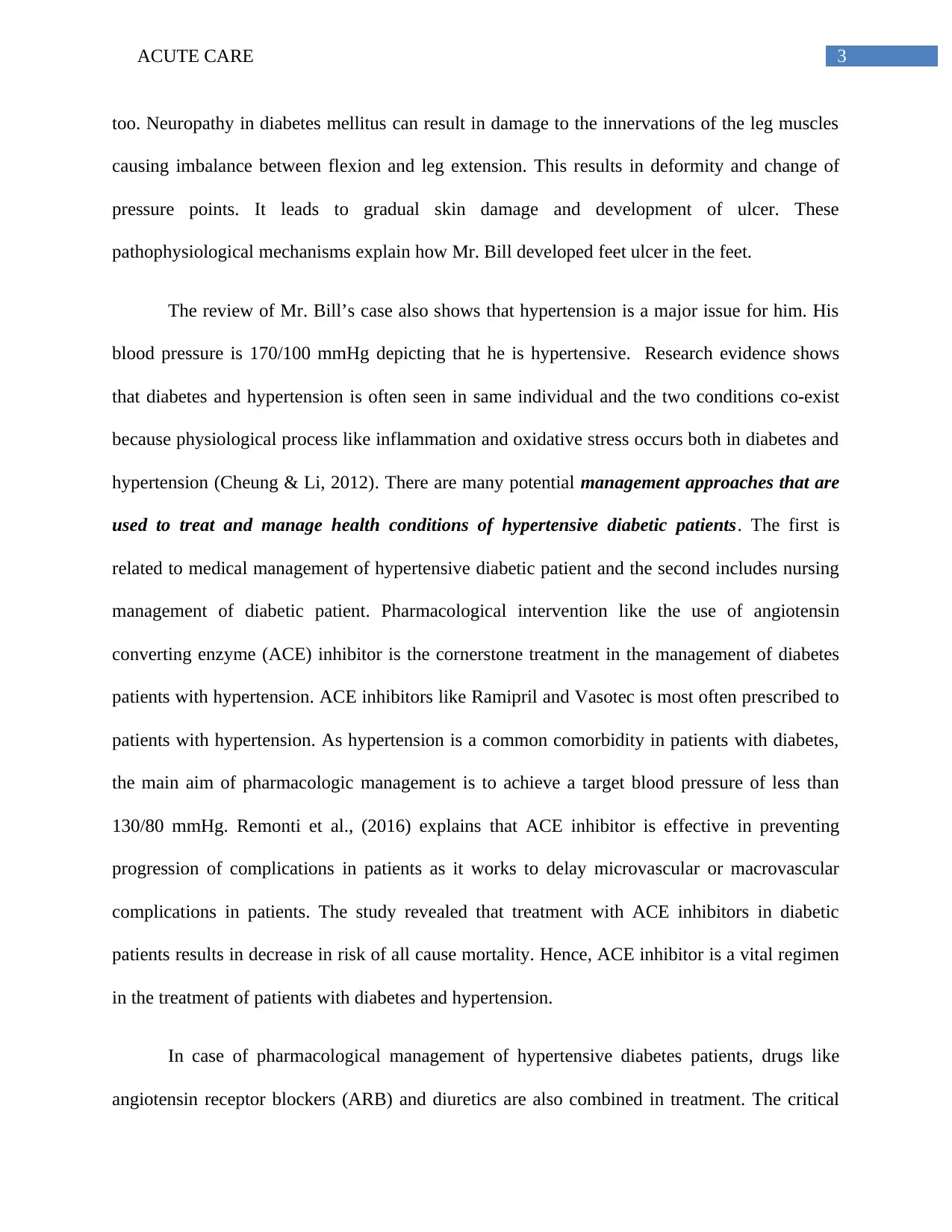
3ACUTE CARE
too. Neuropathy in diabetes mellitus can result in damage to the innervations of the leg muscles
causing imbalance between flexion and leg extension. This results in deformity and change of
pressure points. It leads to gradual skin damage and development of ulcer. These
pathophysiological mechanisms explain how Mr. Bill developed feet ulcer in the feet.
The review of Mr. Bill’s case also shows that hypertension is a major issue for him. His
blood pressure is 170/100 mmHg depicting that he is hypertensive. Research evidence shows
that diabetes and hypertension is often seen in same individual and the two conditions co-exist
because physiological process like inflammation and oxidative stress occurs both in diabetes and
hypertension (Cheung & Li, 2012). There are many potential management approaches that are
used to treat and manage health conditions of hypertensive diabetic patients. The first is
related to medical management of hypertensive diabetic patient and the second includes nursing
management of diabetic patient. Pharmacological intervention like the use of angiotensin
converting enzyme (ACE) inhibitor is the cornerstone treatment in the management of diabetes
patients with hypertension. ACE inhibitors like Ramipril and Vasotec is most often prescribed to
patients with hypertension. As hypertension is a common comorbidity in patients with diabetes,
the main aim of pharmacologic management is to achieve a target blood pressure of less than
130/80 mmHg. Remonti et al., (2016) explains that ACE inhibitor is effective in preventing
progression of complications in patients as it works to delay microvascular or macrovascular
complications in patients. The study revealed that treatment with ACE inhibitors in diabetic
patients results in decrease in risk of all cause mortality. Hence, ACE inhibitor is a vital regimen
in the treatment of patients with diabetes and hypertension.
In case of pharmacological management of hypertensive diabetes patients, drugs like
angiotensin receptor blockers (ARB) and diuretics are also combined in treatment. The critical
too. Neuropathy in diabetes mellitus can result in damage to the innervations of the leg muscles
causing imbalance between flexion and leg extension. This results in deformity and change of
pressure points. It leads to gradual skin damage and development of ulcer. These
pathophysiological mechanisms explain how Mr. Bill developed feet ulcer in the feet.
The review of Mr. Bill’s case also shows that hypertension is a major issue for him. His
blood pressure is 170/100 mmHg depicting that he is hypertensive. Research evidence shows
that diabetes and hypertension is often seen in same individual and the two conditions co-exist
because physiological process like inflammation and oxidative stress occurs both in diabetes and
hypertension (Cheung & Li, 2012). There are many potential management approaches that are
used to treat and manage health conditions of hypertensive diabetic patients. The first is
related to medical management of hypertensive diabetic patient and the second includes nursing
management of diabetic patient. Pharmacological intervention like the use of angiotensin
converting enzyme (ACE) inhibitor is the cornerstone treatment in the management of diabetes
patients with hypertension. ACE inhibitors like Ramipril and Vasotec is most often prescribed to
patients with hypertension. As hypertension is a common comorbidity in patients with diabetes,
the main aim of pharmacologic management is to achieve a target blood pressure of less than
130/80 mmHg. Remonti et al., (2016) explains that ACE inhibitor is effective in preventing
progression of complications in patients as it works to delay microvascular or macrovascular
complications in patients. The study revealed that treatment with ACE inhibitors in diabetic
patients results in decrease in risk of all cause mortality. Hence, ACE inhibitor is a vital regimen
in the treatment of patients with diabetes and hypertension.
In case of pharmacological management of hypertensive diabetes patients, drugs like
angiotensin receptor blockers (ARB) and diuretics are also combined in treatment. The critical
Secure Best Marks with AI Grader
Need help grading? Try our AI Grader for instant feedback on your assignments.
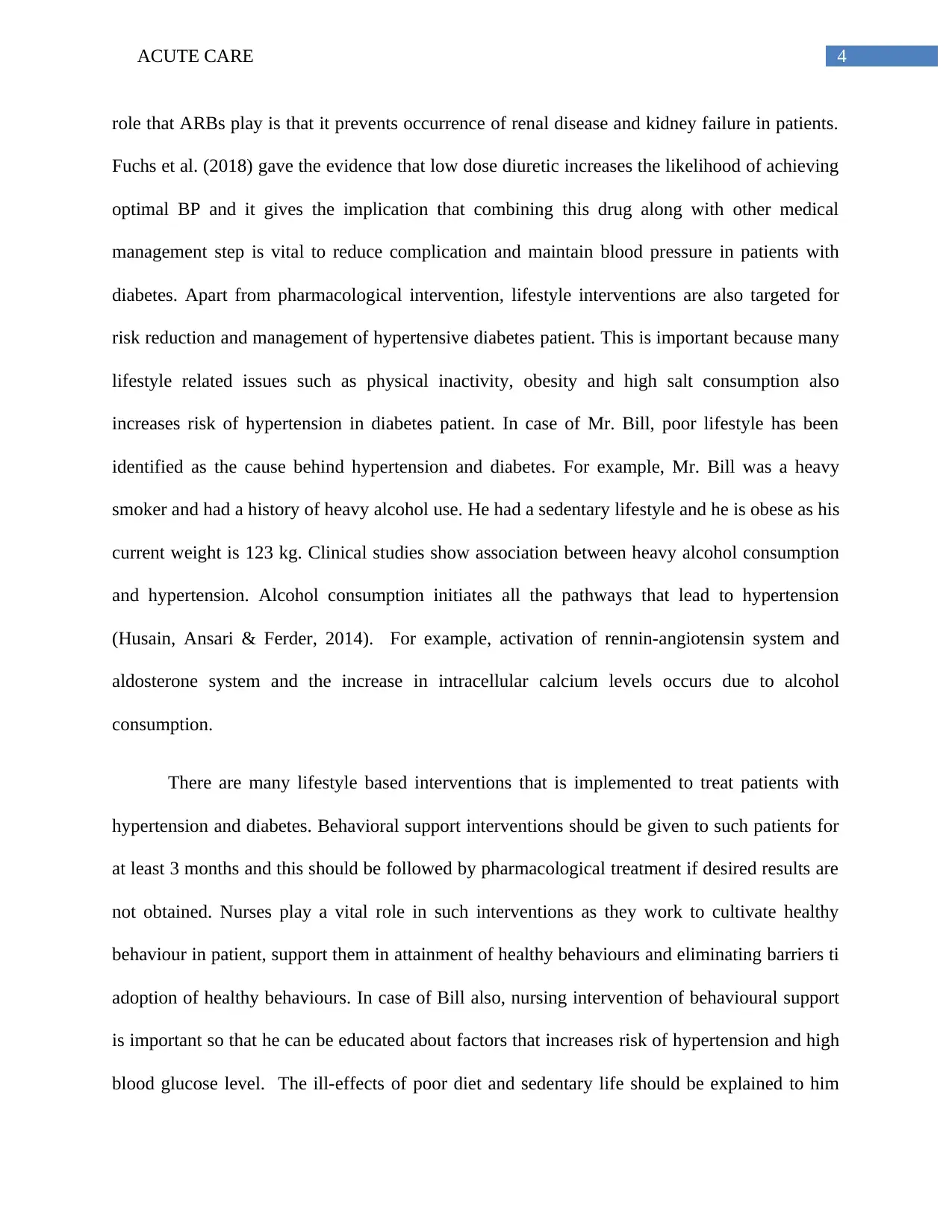
4ACUTE CARE
role that ARBs play is that it prevents occurrence of renal disease and kidney failure in patients.
Fuchs et al. (2018) gave the evidence that low dose diuretic increases the likelihood of achieving
optimal BP and it gives the implication that combining this drug along with other medical
management step is vital to reduce complication and maintain blood pressure in patients with
diabetes. Apart from pharmacological intervention, lifestyle interventions are also targeted for
risk reduction and management of hypertensive diabetes patient. This is important because many
lifestyle related issues such as physical inactivity, obesity and high salt consumption also
increases risk of hypertension in diabetes patient. In case of Mr. Bill, poor lifestyle has been
identified as the cause behind hypertension and diabetes. For example, Mr. Bill was a heavy
smoker and had a history of heavy alcohol use. He had a sedentary lifestyle and he is obese as his
current weight is 123 kg. Clinical studies show association between heavy alcohol consumption
and hypertension. Alcohol consumption initiates all the pathways that lead to hypertension
(Husain, Ansari & Ferder, 2014). For example, activation of rennin-angiotensin system and
aldosterone system and the increase in intracellular calcium levels occurs due to alcohol
consumption.
There are many lifestyle based interventions that is implemented to treat patients with
hypertension and diabetes. Behavioral support interventions should be given to such patients for
at least 3 months and this should be followed by pharmacological treatment if desired results are
not obtained. Nurses play a vital role in such interventions as they work to cultivate healthy
behaviour in patient, support them in attainment of healthy behaviours and eliminating barriers ti
adoption of healthy behaviours. In case of Bill also, nursing intervention of behavioural support
is important so that he can be educated about factors that increases risk of hypertension and high
blood glucose level. The ill-effects of poor diet and sedentary life should be explained to him
role that ARBs play is that it prevents occurrence of renal disease and kidney failure in patients.
Fuchs et al. (2018) gave the evidence that low dose diuretic increases the likelihood of achieving
optimal BP and it gives the implication that combining this drug along with other medical
management step is vital to reduce complication and maintain blood pressure in patients with
diabetes. Apart from pharmacological intervention, lifestyle interventions are also targeted for
risk reduction and management of hypertensive diabetes patient. This is important because many
lifestyle related issues such as physical inactivity, obesity and high salt consumption also
increases risk of hypertension in diabetes patient. In case of Mr. Bill, poor lifestyle has been
identified as the cause behind hypertension and diabetes. For example, Mr. Bill was a heavy
smoker and had a history of heavy alcohol use. He had a sedentary lifestyle and he is obese as his
current weight is 123 kg. Clinical studies show association between heavy alcohol consumption
and hypertension. Alcohol consumption initiates all the pathways that lead to hypertension
(Husain, Ansari & Ferder, 2014). For example, activation of rennin-angiotensin system and
aldosterone system and the increase in intracellular calcium levels occurs due to alcohol
consumption.
There are many lifestyle based interventions that is implemented to treat patients with
hypertension and diabetes. Behavioral support interventions should be given to such patients for
at least 3 months and this should be followed by pharmacological treatment if desired results are
not obtained. Nurses play a vital role in such interventions as they work to cultivate healthy
behaviour in patient, support them in attainment of healthy behaviours and eliminating barriers ti
adoption of healthy behaviours. In case of Bill also, nursing intervention of behavioural support
is important so that he can be educated about factors that increases risk of hypertension and high
blood glucose level. The ill-effects of poor diet and sedentary life should be explained to him
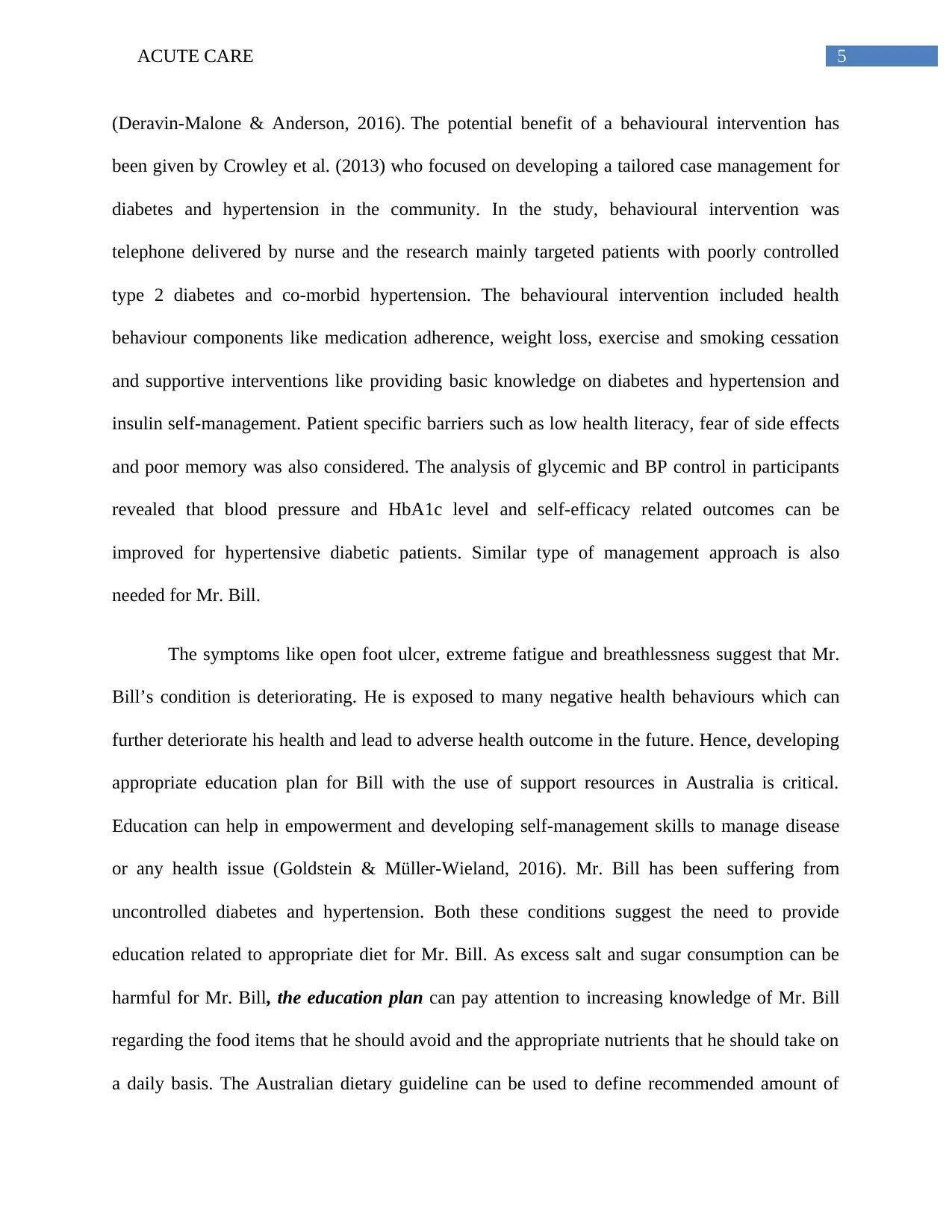
5ACUTE CARE
(Deravin-Malone & Anderson, 2016). The potential benefit of a behavioural intervention has
been given by Crowley et al. (2013) who focused on developing a tailored case management for
diabetes and hypertension in the community. In the study, behavioural intervention was
telephone delivered by nurse and the research mainly targeted patients with poorly controlled
type 2 diabetes and co-morbid hypertension. The behavioural intervention included health
behaviour components like medication adherence, weight loss, exercise and smoking cessation
and supportive interventions like providing basic knowledge on diabetes and hypertension and
insulin self-management. Patient specific barriers such as low health literacy, fear of side effects
and poor memory was also considered. The analysis of glycemic and BP control in participants
revealed that blood pressure and HbA1c level and self-efficacy related outcomes can be
improved for hypertensive diabetic patients. Similar type of management approach is also
needed for Mr. Bill.
The symptoms like open foot ulcer, extreme fatigue and breathlessness suggest that Mr.
Bill’s condition is deteriorating. He is exposed to many negative health behaviours which can
further deteriorate his health and lead to adverse health outcome in the future. Hence, developing
appropriate education plan for Bill with the use of support resources in Australia is critical.
Education can help in empowerment and developing self-management skills to manage disease
or any health issue (Goldstein & Müller-Wieland, 2016). Mr. Bill has been suffering from
uncontrolled diabetes and hypertension. Both these conditions suggest the need to provide
education related to appropriate diet for Mr. Bill. As excess salt and sugar consumption can be
harmful for Mr. Bill, the education plan can pay attention to increasing knowledge of Mr. Bill
regarding the food items that he should avoid and the appropriate nutrients that he should take on
a daily basis. The Australian dietary guideline can be used to define recommended amount of
(Deravin-Malone & Anderson, 2016). The potential benefit of a behavioural intervention has
been given by Crowley et al. (2013) who focused on developing a tailored case management for
diabetes and hypertension in the community. In the study, behavioural intervention was
telephone delivered by nurse and the research mainly targeted patients with poorly controlled
type 2 diabetes and co-morbid hypertension. The behavioural intervention included health
behaviour components like medication adherence, weight loss, exercise and smoking cessation
and supportive interventions like providing basic knowledge on diabetes and hypertension and
insulin self-management. Patient specific barriers such as low health literacy, fear of side effects
and poor memory was also considered. The analysis of glycemic and BP control in participants
revealed that blood pressure and HbA1c level and self-efficacy related outcomes can be
improved for hypertensive diabetic patients. Similar type of management approach is also
needed for Mr. Bill.
The symptoms like open foot ulcer, extreme fatigue and breathlessness suggest that Mr.
Bill’s condition is deteriorating. He is exposed to many negative health behaviours which can
further deteriorate his health and lead to adverse health outcome in the future. Hence, developing
appropriate education plan for Bill with the use of support resources in Australia is critical.
Education can help in empowerment and developing self-management skills to manage disease
or any health issue (Goldstein & Müller-Wieland, 2016). Mr. Bill has been suffering from
uncontrolled diabetes and hypertension. Both these conditions suggest the need to provide
education related to appropriate diet for Mr. Bill. As excess salt and sugar consumption can be
harmful for Mr. Bill, the education plan can pay attention to increasing knowledge of Mr. Bill
regarding the food items that he should avoid and the appropriate nutrients that he should take on
a daily basis. The Australian dietary guideline can be used to define recommended amount of
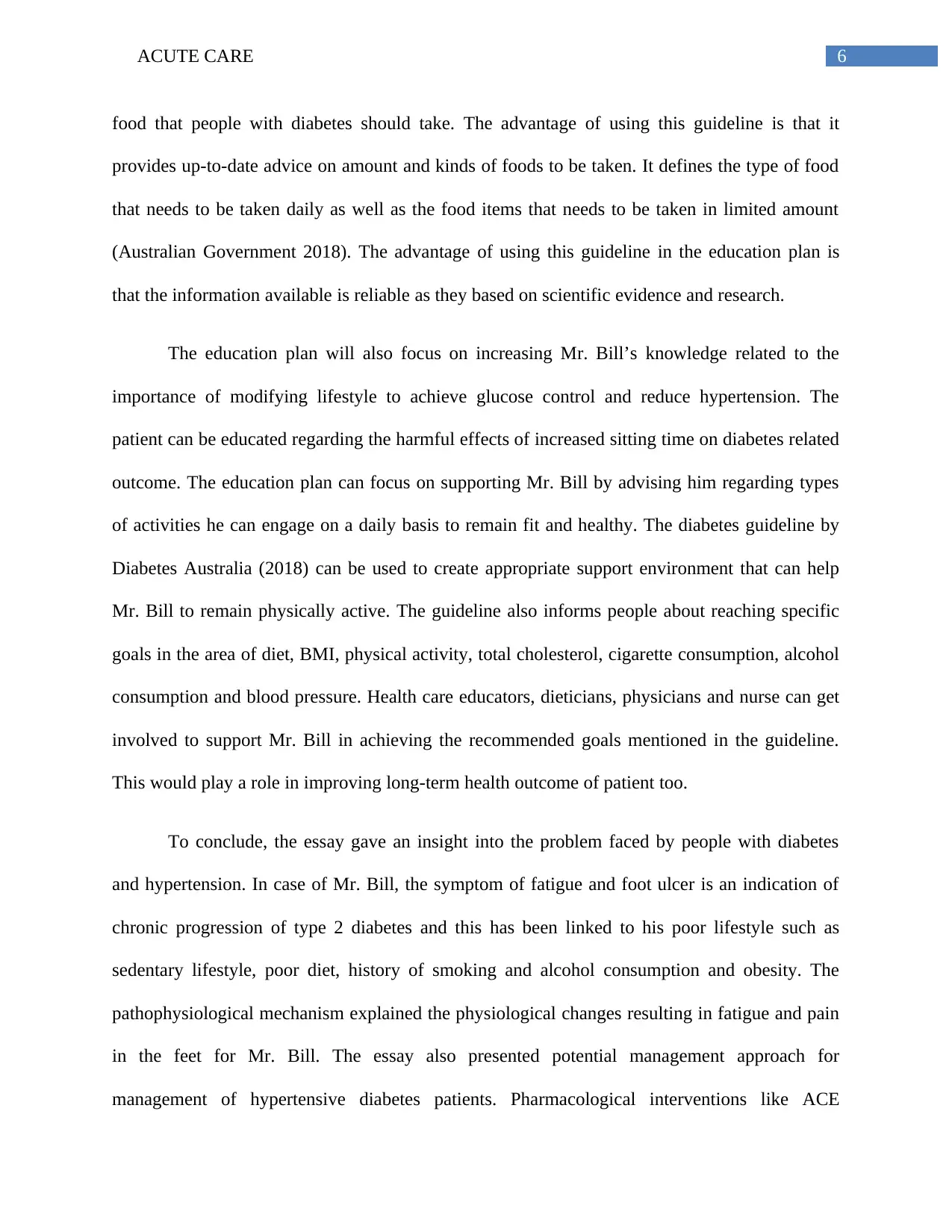
6ACUTE CARE
food that people with diabetes should take. The advantage of using this guideline is that it
provides up-to-date advice on amount and kinds of foods to be taken. It defines the type of food
that needs to be taken daily as well as the food items that needs to be taken in limited amount
(Australian Government 2018). The advantage of using this guideline in the education plan is
that the information available is reliable as they based on scientific evidence and research.
The education plan will also focus on increasing Mr. Bill’s knowledge related to the
importance of modifying lifestyle to achieve glucose control and reduce hypertension. The
patient can be educated regarding the harmful effects of increased sitting time on diabetes related
outcome. The education plan can focus on supporting Mr. Bill by advising him regarding types
of activities he can engage on a daily basis to remain fit and healthy. The diabetes guideline by
Diabetes Australia (2018) can be used to create appropriate support environment that can help
Mr. Bill to remain physically active. The guideline also informs people about reaching specific
goals in the area of diet, BMI, physical activity, total cholesterol, cigarette consumption, alcohol
consumption and blood pressure. Health care educators, dieticians, physicians and nurse can get
involved to support Mr. Bill in achieving the recommended goals mentioned in the guideline.
This would play a role in improving long-term health outcome of patient too.
To conclude, the essay gave an insight into the problem faced by people with diabetes
and hypertension. In case of Mr. Bill, the symptom of fatigue and foot ulcer is an indication of
chronic progression of type 2 diabetes and this has been linked to his poor lifestyle such as
sedentary lifestyle, poor diet, history of smoking and alcohol consumption and obesity. The
pathophysiological mechanism explained the physiological changes resulting in fatigue and pain
in the feet for Mr. Bill. The essay also presented potential management approach for
management of hypertensive diabetes patients. Pharmacological interventions like ACE
food that people with diabetes should take. The advantage of using this guideline is that it
provides up-to-date advice on amount and kinds of foods to be taken. It defines the type of food
that needs to be taken daily as well as the food items that needs to be taken in limited amount
(Australian Government 2018). The advantage of using this guideline in the education plan is
that the information available is reliable as they based on scientific evidence and research.
The education plan will also focus on increasing Mr. Bill’s knowledge related to the
importance of modifying lifestyle to achieve glucose control and reduce hypertension. The
patient can be educated regarding the harmful effects of increased sitting time on diabetes related
outcome. The education plan can focus on supporting Mr. Bill by advising him regarding types
of activities he can engage on a daily basis to remain fit and healthy. The diabetes guideline by
Diabetes Australia (2018) can be used to create appropriate support environment that can help
Mr. Bill to remain physically active. The guideline also informs people about reaching specific
goals in the area of diet, BMI, physical activity, total cholesterol, cigarette consumption, alcohol
consumption and blood pressure. Health care educators, dieticians, physicians and nurse can get
involved to support Mr. Bill in achieving the recommended goals mentioned in the guideline.
This would play a role in improving long-term health outcome of patient too.
To conclude, the essay gave an insight into the problem faced by people with diabetes
and hypertension. In case of Mr. Bill, the symptom of fatigue and foot ulcer is an indication of
chronic progression of type 2 diabetes and this has been linked to his poor lifestyle such as
sedentary lifestyle, poor diet, history of smoking and alcohol consumption and obesity. The
pathophysiological mechanism explained the physiological changes resulting in fatigue and pain
in the feet for Mr. Bill. The essay also presented potential management approach for
management of hypertensive diabetes patients. Pharmacological interventions like ACE
Paraphrase This Document
Need a fresh take? Get an instant paraphrase of this document with our AI Paraphraser
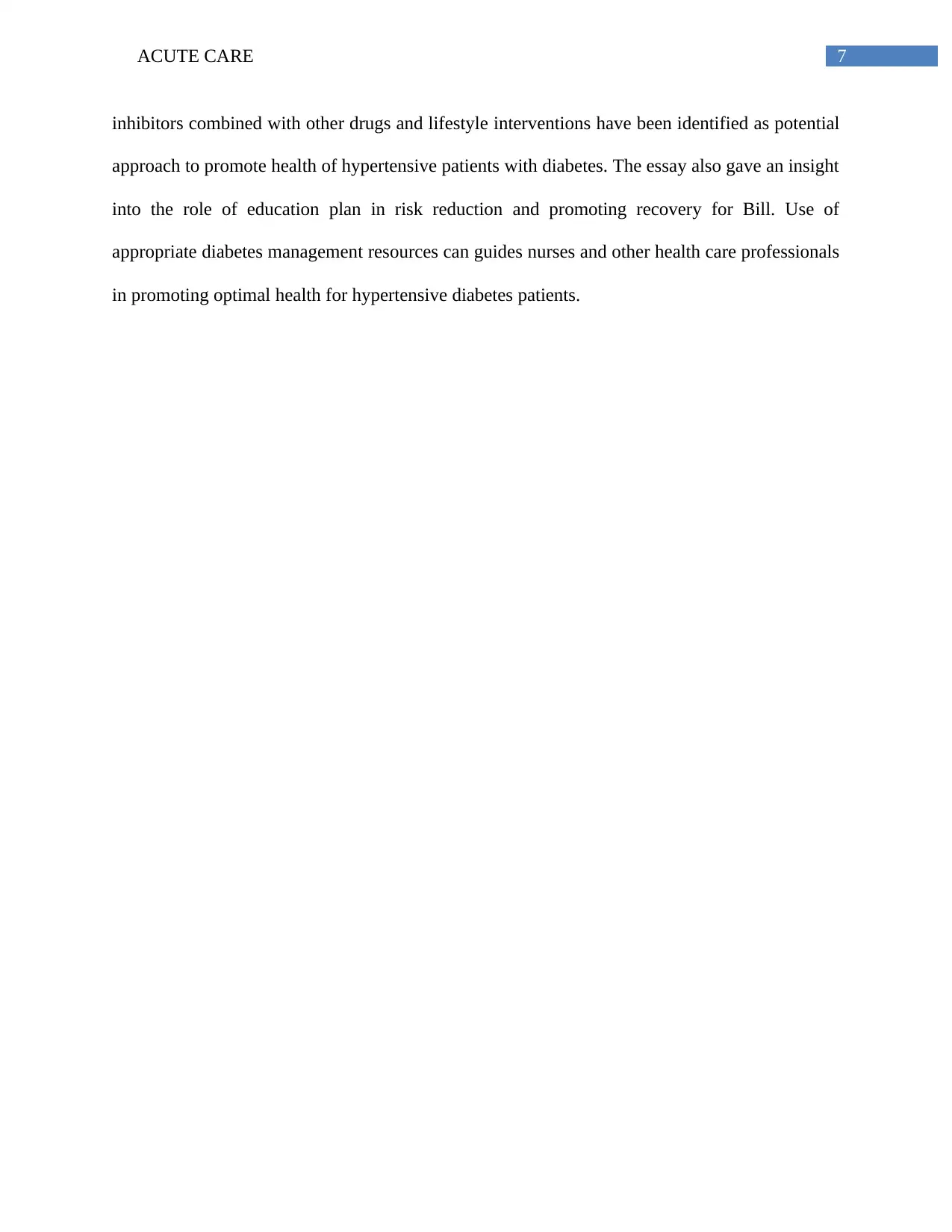
7ACUTE CARE
inhibitors combined with other drugs and lifestyle interventions have been identified as potential
approach to promote health of hypertensive patients with diabetes. The essay also gave an insight
into the role of education plan in risk reduction and promoting recovery for Bill. Use of
appropriate diabetes management resources can guides nurses and other health care professionals
in promoting optimal health for hypertensive diabetes patients.
inhibitors combined with other drugs and lifestyle interventions have been identified as potential
approach to promote health of hypertensive patients with diabetes. The essay also gave an insight
into the role of education plan in risk reduction and promoting recovery for Bill. Use of
appropriate diabetes management resources can guides nurses and other health care professionals
in promoting optimal health for hypertensive diabetes patients.
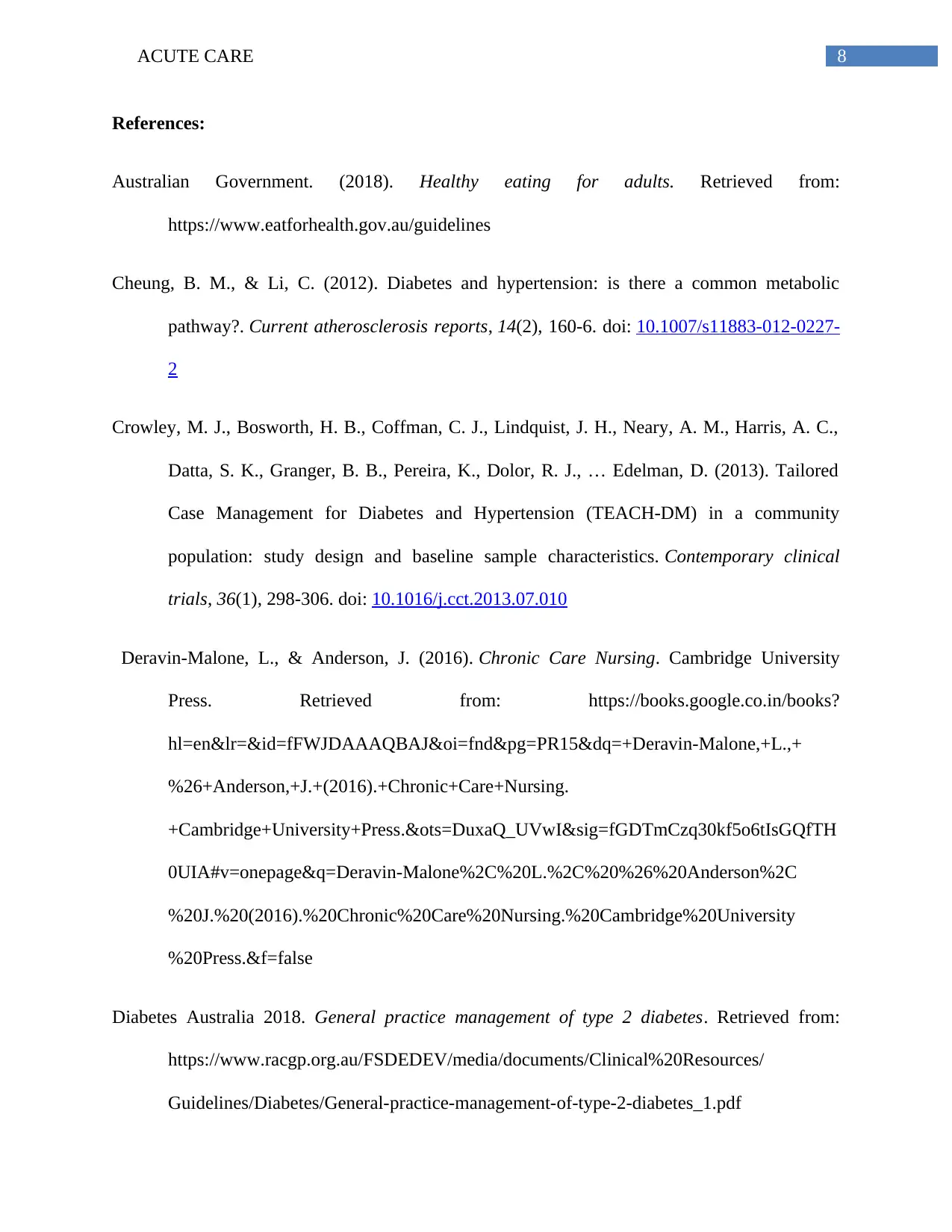
8ACUTE CARE
References:
Australian Government. (2018). Healthy eating for adults. Retrieved from:
https://www.eatforhealth.gov.au/guidelines
Cheung, B. M., & Li, C. (2012). Diabetes and hypertension: is there a common metabolic
pathway?. Current atherosclerosis reports, 14(2), 160-6. doi: 10.1007/s11883-012-0227-
2
Crowley, M. J., Bosworth, H. B., Coffman, C. J., Lindquist, J. H., Neary, A. M., Harris, A. C.,
Datta, S. K., Granger, B. B., Pereira, K., Dolor, R. J., … Edelman, D. (2013). Tailored
Case Management for Diabetes and Hypertension (TEACH-DM) in a community
population: study design and baseline sample characteristics. Contemporary clinical
trials, 36(1), 298-306. doi: 10.1016/j.cct.2013.07.010
Deravin-Malone, L., & Anderson, J. (2016). Chronic Care Nursing. Cambridge University
Press. Retrieved from: https://books.google.co.in/books?
hl=en&lr=&id=fFWJDAAAQBAJ&oi=fnd&pg=PR15&dq=+Deravin-Malone,+L.,+
%26+Anderson,+J.+(2016).+Chronic+Care+Nursing.
+Cambridge+University+Press.&ots=DuxaQ_UVwI&sig=fGDTmCzq30kf5o6tIsGQfTH
0UIA#v=onepage&q=Deravin-Malone%2C%20L.%2C%20%26%20Anderson%2C
%20J.%20(2016).%20Chronic%20Care%20Nursing.%20Cambridge%20University
%20Press.&f=false
Diabetes Australia 2018. General practice management of type 2 diabetes. Retrieved from:
https://www.racgp.org.au/FSDEDEV/media/documents/Clinical%20Resources/
Guidelines/Diabetes/General-practice-management-of-type-2-diabetes_1.pdf
References:
Australian Government. (2018). Healthy eating for adults. Retrieved from:
https://www.eatforhealth.gov.au/guidelines
Cheung, B. M., & Li, C. (2012). Diabetes and hypertension: is there a common metabolic
pathway?. Current atherosclerosis reports, 14(2), 160-6. doi: 10.1007/s11883-012-0227-
2
Crowley, M. J., Bosworth, H. B., Coffman, C. J., Lindquist, J. H., Neary, A. M., Harris, A. C.,
Datta, S. K., Granger, B. B., Pereira, K., Dolor, R. J., … Edelman, D. (2013). Tailored
Case Management for Diabetes and Hypertension (TEACH-DM) in a community
population: study design and baseline sample characteristics. Contemporary clinical
trials, 36(1), 298-306. doi: 10.1016/j.cct.2013.07.010
Deravin-Malone, L., & Anderson, J. (2016). Chronic Care Nursing. Cambridge University
Press. Retrieved from: https://books.google.co.in/books?
hl=en&lr=&id=fFWJDAAAQBAJ&oi=fnd&pg=PR15&dq=+Deravin-Malone,+L.,+
%26+Anderson,+J.+(2016).+Chronic+Care+Nursing.
+Cambridge+University+Press.&ots=DuxaQ_UVwI&sig=fGDTmCzq30kf5o6tIsGQfTH
0UIA#v=onepage&q=Deravin-Malone%2C%20L.%2C%20%26%20Anderson%2C
%20J.%20(2016).%20Chronic%20Care%20Nursing.%20Cambridge%20University
%20Press.&f=false
Diabetes Australia 2018. General practice management of type 2 diabetes. Retrieved from:
https://www.racgp.org.au/FSDEDEV/media/documents/Clinical%20Resources/
Guidelines/Diabetes/General-practice-management-of-type-2-diabetes_1.pdf

9ACUTE CARE
Fritschi, C., & Quinn, L. (2010). Fatigue in patients with diabetes: a review. Journal of
psychosomatic research, 69(1), 33-41. doi: 10.1016/j.jpsychores.2010.01.021
Fuchs, F. D., Fuchs, S. C., Poli-de-Figueiredo, C. E., Figueiredo Neto, J. A., Scala, L. C. N.,
Vilela-Martin, J. F., ... & Silva, R. P. (2018). Effectiveness of low-dose diuretics for
blood pressure reduction to optimal values in prehypertension: a randomized clinical
trial. Journal of hypertension, 36(4), 933-938.DOI:10.1097/HJH.0000000000001624
Goldstein, B. J., & Müller-Wieland, D. (Eds.). (2016). Type 2 diabetes: principles and practice.
CRC Press. Retrieved from: https://books.google.co.in/books?
hl=en&lr=&id=dMKc6OTvX3EC&oi=fnd&pg=PP1&dq=diabetes+education,
+book&ots=ButUGTRfuS&sig=Ln02cbpM-cO809fzUPCnMTN7moA
Holt, R. I., Cockram, C., Flyvbjerg, A., & Goldstein, B. J. (Eds.). (2017). Textbook of diabetes.
John Wiley & Sons. Retrieved from:
http://library02.embl.de/InmagicGenie/DocumentFolder/TableofContents_H487.pdf
Husain, K., Ansari, R. A., & Ferder, L. (2014). Alcohol-induced hypertension: Mechanism and
prevention. World journal of cardiology, 6(5), 245-52. doi: 10.4330/wjc.v6.i5.245
Kahn, S. E., Cooper, M. E., & Del Prato, S. (2013). Pathophysiology and treatment of type 2
diabetes: perspectives on the past, present, and future. Lancet (London,
England), 383(9922), 1068-83. doi: 10.1016/S0140-6736(13)62154-6
Kalra, S., & Sahay, R. (2018). Diabetes Fatigue Syndrome. Diabetes therapy : research,
treatment and education of diabetes and related disorders, 9(4), 1421-1429.
doi: 10.1007/s13300-018-0453-x
Fritschi, C., & Quinn, L. (2010). Fatigue in patients with diabetes: a review. Journal of
psychosomatic research, 69(1), 33-41. doi: 10.1016/j.jpsychores.2010.01.021
Fuchs, F. D., Fuchs, S. C., Poli-de-Figueiredo, C. E., Figueiredo Neto, J. A., Scala, L. C. N.,
Vilela-Martin, J. F., ... & Silva, R. P. (2018). Effectiveness of low-dose diuretics for
blood pressure reduction to optimal values in prehypertension: a randomized clinical
trial. Journal of hypertension, 36(4), 933-938.DOI:10.1097/HJH.0000000000001624
Goldstein, B. J., & Müller-Wieland, D. (Eds.). (2016). Type 2 diabetes: principles and practice.
CRC Press. Retrieved from: https://books.google.co.in/books?
hl=en&lr=&id=dMKc6OTvX3EC&oi=fnd&pg=PP1&dq=diabetes+education,
+book&ots=ButUGTRfuS&sig=Ln02cbpM-cO809fzUPCnMTN7moA
Holt, R. I., Cockram, C., Flyvbjerg, A., & Goldstein, B. J. (Eds.). (2017). Textbook of diabetes.
John Wiley & Sons. Retrieved from:
http://library02.embl.de/InmagicGenie/DocumentFolder/TableofContents_H487.pdf
Husain, K., Ansari, R. A., & Ferder, L. (2014). Alcohol-induced hypertension: Mechanism and
prevention. World journal of cardiology, 6(5), 245-52. doi: 10.4330/wjc.v6.i5.245
Kahn, S. E., Cooper, M. E., & Del Prato, S. (2013). Pathophysiology and treatment of type 2
diabetes: perspectives on the past, present, and future. Lancet (London,
England), 383(9922), 1068-83. doi: 10.1016/S0140-6736(13)62154-6
Kalra, S., & Sahay, R. (2018). Diabetes Fatigue Syndrome. Diabetes therapy : research,
treatment and education of diabetes and related disorders, 9(4), 1421-1429.
doi: 10.1007/s13300-018-0453-x
Secure Best Marks with AI Grader
Need help grading? Try our AI Grader for instant feedback on your assignments.
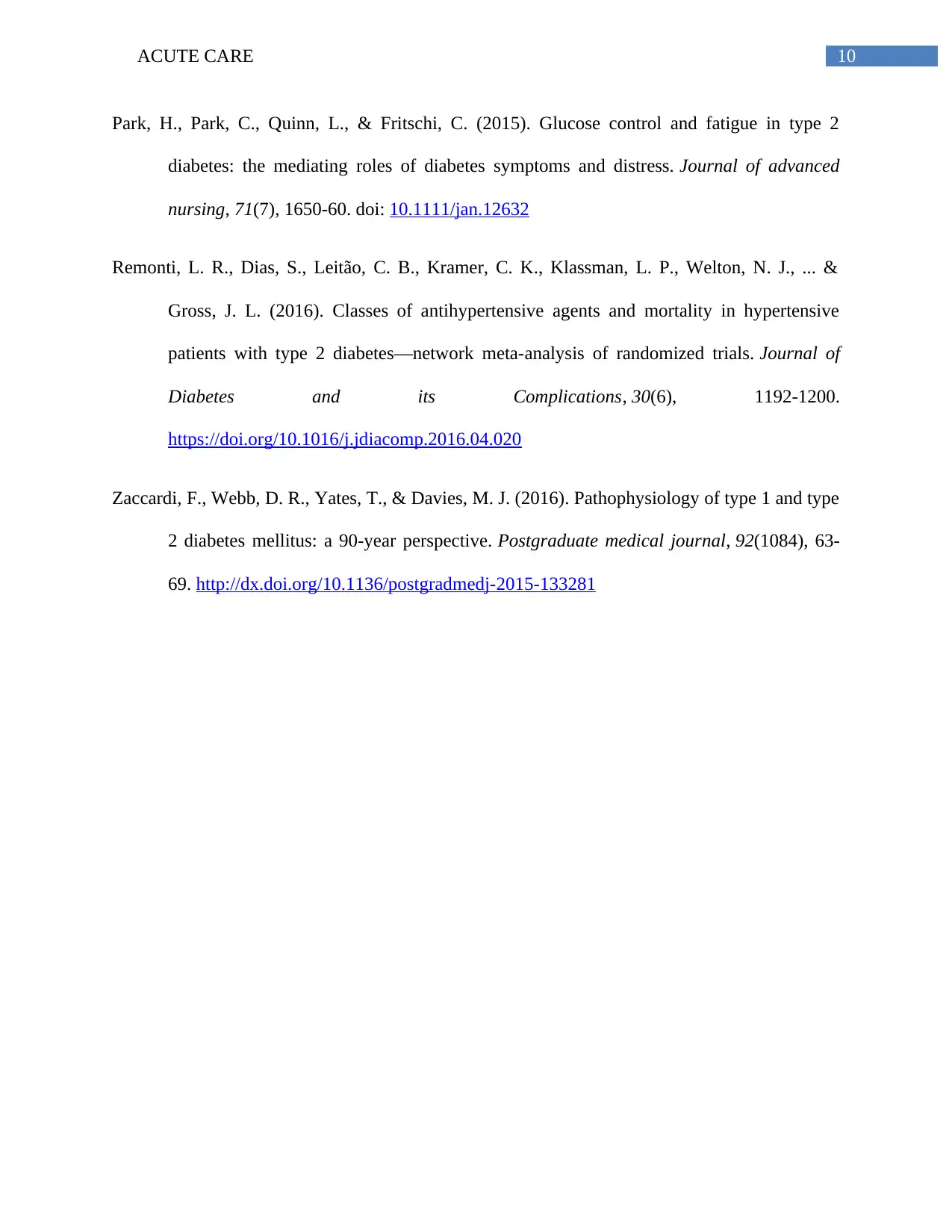
10ACUTE CARE
Park, H., Park, C., Quinn, L., & Fritschi, C. (2015). Glucose control and fatigue in type 2
diabetes: the mediating roles of diabetes symptoms and distress. Journal of advanced
nursing, 71(7), 1650-60. doi: 10.1111/jan.12632
Remonti, L. R., Dias, S., Leitão, C. B., Kramer, C. K., Klassman, L. P., Welton, N. J., ... &
Gross, J. L. (2016). Classes of antihypertensive agents and mortality in hypertensive
patients with type 2 diabetes—network meta-analysis of randomized trials. Journal of
Diabetes and its Complications, 30(6), 1192-1200.
https://doi.org/10.1016/j.jdiacomp.2016.04.020
Zaccardi, F., Webb, D. R., Yates, T., & Davies, M. J. (2016). Pathophysiology of type 1 and type
2 diabetes mellitus: a 90-year perspective. Postgraduate medical journal, 92(1084), 63-
69. http://dx.doi.org/10.1136/postgradmedj-2015-133281
Park, H., Park, C., Quinn, L., & Fritschi, C. (2015). Glucose control and fatigue in type 2
diabetes: the mediating roles of diabetes symptoms and distress. Journal of advanced
nursing, 71(7), 1650-60. doi: 10.1111/jan.12632
Remonti, L. R., Dias, S., Leitão, C. B., Kramer, C. K., Klassman, L. P., Welton, N. J., ... &
Gross, J. L. (2016). Classes of antihypertensive agents and mortality in hypertensive
patients with type 2 diabetes—network meta-analysis of randomized trials. Journal of
Diabetes and its Complications, 30(6), 1192-1200.
https://doi.org/10.1016/j.jdiacomp.2016.04.020
Zaccardi, F., Webb, D. R., Yates, T., & Davies, M. J. (2016). Pathophysiology of type 1 and type
2 diabetes mellitus: a 90-year perspective. Postgraduate medical journal, 92(1084), 63-
69. http://dx.doi.org/10.1136/postgradmedj-2015-133281
1 out of 11
Related Documents
Your All-in-One AI-Powered Toolkit for Academic Success.
+13062052269
info@desklib.com
Available 24*7 on WhatsApp / Email
![[object Object]](/_next/static/media/star-bottom.7253800d.svg)
Unlock your academic potential
© 2024 | Zucol Services PVT LTD | All rights reserved.





